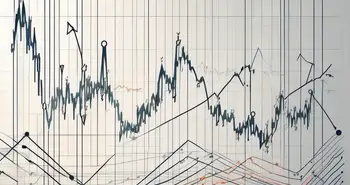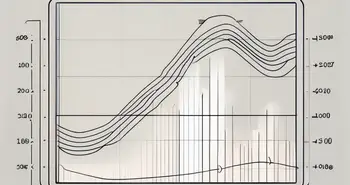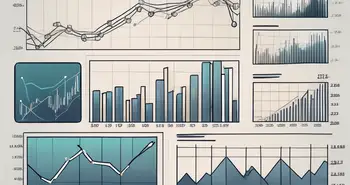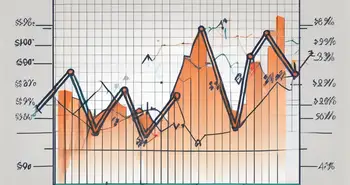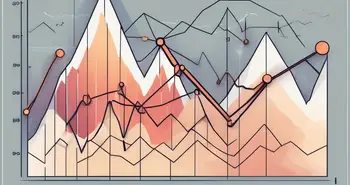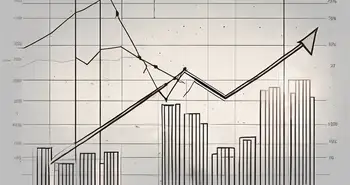Stochastic Forex Trading

As an expert in the field of Stochastic Forex trading, I have seen firsthand how mastering this market can lead to significant profits. In this comprehensive guide, I will walk you through the basics of Stochastic Forex, the mechanics behind it, strategies for successful trading, and common mistakes to avoid. By the end of this article, you will have the knowledge and skills to navigate the Stochastic Forex market with confidence.
The Basics of Stochastic Forex
Stochastic Forex is a powerful technical analysis tool used by traders to identify overbought and oversold conditions in the market. It helps us determine when an asset's price has deviated too far from its average price. By understanding and interpreting the Stochastic Oscillator, we can make informed trading decisions.
But what exactly is the Stochastic Oscillator? It is a momentum indicator that compares the closing price of a currency pair to its price range over a specific period. This comparison provides insights into the strength and potential reversal points of a trend.
Traders often use the Stochastic Oscillator to identify potential entry and exit points in the market. When the indicator shows that a currency pair is overbought, it suggests that the price may soon reverse and move downwards. On the other hand, when the indicator indicates oversold conditions, it implies that the price may reverse and move upwards.
However, it's important to note that the Stochastic Oscillator is not a standalone indicator. It is most effective when used in conjunction with other technical analysis tools and indicators to confirm trading signals.
The Importance of Stochastic Indicators in Forex
The Stochastic indicator is widely used in Forex trading due to its reliability and versatility. It helps us identify potential trend reversals, anticipate price breakouts, and confirm the strength of a current trend. By incorporating Stochastic indicators into our trading strategy, we can increase the accuracy and profitability of our trades.
One of the key benefits of using Stochastic indicators is their ability to provide early signals of potential trend reversals. By monitoring the Stochastic Oscillator, traders can identify when a currency pair is reaching extreme levels, indicating a possible reversal in the price direction.
Moreover, Stochastic indicators can also help traders anticipate price breakouts. When the Stochastic Oscillator shows that a currency pair is in an overbought or oversold condition, it suggests that the price may soon break out of its current range and continue in the direction of the breakout.
Additionally, Stochastic indicators can be used to confirm the strength of a current trend. If the Stochastic Oscillator is showing higher highs and higher lows during an uptrend, it indicates that the trend is strong and likely to continue. Conversely, if the Stochastic Oscillator is showing lower highs and lower lows during a downtrend, it suggests that the trend is strong and likely to persist.
Key Terms and Concepts in Stochastic Forex
Before we dive deeper into Stochastic Forex, let's familiarize ourselves with some essential terms and concepts:
- %K and %D: These are the two lines plotted on the Stochastic Oscillator. %K represents the current price's position relative to the highest high and lowest low over a specified period. %D is a moving average of %K, smoothing out the indicator's fluctuations.
- Overbought and Oversold: When the Stochastic Oscillator rises above 80, it is considered overbought, indicating a potential downward price reversal. Conversely, when it falls below 20, it is considered oversold, suggesting a potential upward price reversal.
- Signal Line Crossovers: When %K crosses above %D, it generates a bullish signal, indicating a buying opportunity. Conversely, when %K crosses below %D, it generates a bearish signal, suggesting a selling opportunity.
Understanding these key terms and concepts is crucial for effectively interpreting and utilizing Stochastic indicators in Forex trading. By mastering the Stochastic Oscillator and its associated indicators, traders can gain a deeper understanding of market dynamics and make more informed trading decisions.
The Mechanics of Stochastic Forex
Stochastic Forex is a popular technical analysis tool used by traders to identify potential trading opportunities in the foreign exchange market. It works by comparing the current closing price of a currency pair to its price range over a selected period. This comparison is done using a mathematical formula that calculates the Stochastic values, which range from 0 to 100.
Values above 80 on the Stochastic indicator indicate an overbought condition, suggesting that the currency pair may be due for a price correction or reversal. On the other hand, values below 20 indicate an oversold condition, implying that the currency pair may be undervalued and could potentially experience a price bounce or rally.
Understanding the Stochastic Oscillator
The Stochastic Oscillator is a technical indicator that consists of two lines, namely the %K line and the %D line. These lines move between 0 and 100, providing traders with valuable insights into the market's momentum and potential trend reversals.
The %K line is more sensitive to price changes and tends to fluctuate more rapidly, reflecting short-term market movements. On the other hand, the %D line is a smoothed version of the %K line, providing a more stable and less volatile view of the market's momentum.
Traders often look for intersections between the %K and %D lines as potential trade signals. When the %K line crosses above the %D line, it is considered a bullish signal, indicating a potential buying opportunity. Conversely, when the %K line crosses below the %D line, it is seen as a bearish signal, suggesting a potential selling opportunity.
Interpreting Stochastic Forex Signals
When trading Stochastic Forex, traders primarily focus on the %K and %D line crossovers, as well as the indicator's positioning relative to overbought and oversold levels. These signals can provide valuable insights into potential market reversals or continuations.
A bullish signal occurs when the %K line crosses above the %D line, indicating a potential shift in momentum towards the upside. To confirm this signal, traders also look for both lines to be below the overbought level, suggesting that the currency pair is not overvalued and still has room to rise.
Conversely, a bearish signal occurs when the %K line crosses below the %D line, indicating a potential shift in momentum towards the downside. Traders also look for both lines to be above the oversold level to confirm this signal, suggesting that the currency pair is not oversold and may have further room to decline.
It is important to note that while Stochastic Forex can be a valuable tool in identifying potential trading opportunities, it should not be used in isolation. Traders often combine it with other technical indicators and analysis techniques to make more informed trading decisions.
Strategies for Stochastic Forex Trading
Stochastic Forex trading is a popular approach for traders looking to capitalize on short-term price fluctuations in the foreign exchange market. By using the Stochastic indicator, traders can identify overbought and oversold conditions, which can be used as signals for potential market reversals. However, developing a successful trading plan and effectively managing risk are crucial for consistent profits in Stochastic Forex trading.
Developing a Stochastic Forex Trading Plan
Before diving into Stochastic Forex trading, it is essential to develop a well-defined trading plan. This plan should encompass your trading goals, risk tolerance, and preferred trading style. By clearly defining these aspects, you can align your trading strategy with your personal objectives and increase your chances of success.
Once you have established your trading plan, the next step is to incorporate Stochastic indicators into your strategy. This involves setting specific entry and exit criteria based on Stochastic signals. For example, you may decide to enter a trade when the Stochastic indicator crosses above the oversold level, indicating a potential buying opportunity. On the other hand, you may choose to exit a trade when the Stochastic indicator reaches the overbought level, suggesting a possible reversal in price.
It is important to note that Stochastic indicators should not be used in isolation. They should be complemented with other technical analysis tools and indicators to confirm trading signals and increase the accuracy of your analysis. By combining Stochastic Forex with other indicators, such as moving averages or trend lines, you can gain a more comprehensive understanding of market conditions and make more informed trading decisions.
Lastly, it is crucial to consistently analyze and adjust your Stochastic Forex trading approach. The foreign exchange market is dynamic and constantly evolving, so it is essential to adapt your strategy to changing market conditions. Regularly reviewing your trading plan, analyzing your trades, and identifying areas for improvement can help you stay ahead of the game and increase your chances of long-term profitability.
Risk Management in Stochastic Forex Trading
Like any trading strategy, risk management plays a vital role in Stochastic Forex trading. Without proper risk management techniques, even the most successful trading plan can lead to significant losses. Therefore, it is crucial to implement effective risk management practices to protect your capital and increase the longevity of your trading career.
One key aspect of risk management in Stochastic Forex trading is proper position sizing. This involves determining the appropriate amount of capital to allocate to each trade based on your risk tolerance and account size. By carefully calculating your position size, you can limit the potential losses on any given trade and protect your overall trading capital.
In addition to position sizing, setting stop-loss orders is another crucial risk management technique. A stop-loss order is an instruction to automatically exit a trade if the price reaches a certain level, thereby limiting potential losses. By placing stop-loss orders at strategic levels, you can protect your trades from unexpected market movements and minimize the impact of losing trades on your overall portfolio.
Furthermore, following a disciplined approach to money management is essential in Stochastic Forex trading. This involves adhering to predetermined risk-reward ratios and avoiding impulsive trading decisions based on emotions. By maintaining discipline and sticking to your trading plan, you can reduce the likelihood of making costly mistakes and increase your chances of long-term success.
Advanced Stochastic Forex Strategies
Once you have mastered the basics of Stochastic Forex trading, you may consider exploring more advanced strategies to further enhance your trading skills. One such strategy is divergence trading, which involves identifying discrepancies between price movements and Stochastic signals.
Divergence occurs when the price of a currency pair moves in the opposite direction of the Stochastic indicator. For example, if the price of a currency pair is making higher highs, but the Stochastic indicator is making lower highs, it could indicate a potential reversal in price. By recognizing these divergences, traders can anticipate market reversals and take advantage of profitable trading opportunities.
In addition to divergence trading, you can also combine Stochastic Forex with other technical indicators or trading tools to enhance your analysis. For instance, you may use the Stochastic indicator in conjunction with trend lines or moving averages to confirm trading signals and increase the reliability of your analysis. By incorporating multiple indicators, you can gain a more comprehensive view of market conditions and make more accurate trading decisions.
It is important to note that advanced Stochastic Forex strategies require a deeper understanding of technical analysis and market dynamics. Therefore, it is recommended to thoroughly study and practice these strategies in a demo trading environment before applying them to live trading accounts.
In conclusion, Stochastic Forex trading offers traders a valuable tool for identifying potential market reversals and capitalizing on short-term price fluctuations. By developing a well-defined trading plan, effectively managing risk, and exploring advanced strategies, traders can increase their chances of success in the dynamic and exciting world of Stochastic Forex trading.
Common Mistakes in Stochastic Forex Trading
Overreliance on Stochastic Indicators
While Stochastic indicators are essential, relying solely on them can be detrimental. To avoid this mistake, combine Stochastic signals with other technical indicators or fundamental analysis to gain a broader perspective on the market. Remember, no single indicator can guarantee accurate predictions all the time.
Misinterpreting Stochastic Signals
Interpreting Stochastic signals requires practice and experience. Avoid making hasty trading decisions based solely on one signal or indicator reading. Take time to consider the overall market context, confirm signals with other indicators, and use proper risk management techniques to reduce the impact of false signals.
Lack of a Comprehensive Trading Strategy
A common mistake among Stochastic Forex traders is the absence of a comprehensive trading strategy. A strategy encompasses more than just signal generation; it includes risk management, analysis techniques, and rules for trade execution. Develop a clear plan and stick to it consistently to maximize your chances of success.
As I reflect on my journey in Stochastic Forex trading, I recall a valuable lesson I learned early on. It is crucial not to let emotions cloud your judgment. Embrace discipline and objectivity in your trading decisions. Stick to your trading plan and never let fear or greed influence your strategy. This mindset will steer you towards long-term profitability and success.
Frequently Asked Questions
What is Stochastic Forex?
Stochastic Forex is a technical analysis tool used by traders to identify overbought and oversold conditions in the market. It helps traders make informed decisions by determining when an asset's price has deviated too far from its average price.
How do Stochastic indicators work?
Stochastic indicators compare the current closing price of a currency pair to its price range over a selected period. The resulting values, ranging from 0 to 100, indicate whether an asset is overbought or oversold.
What are some common mistakes in Stochastic Forex trading?
Common mistakes in Stochastic Forex trading include overreliance on Stochastic indicators, misinterpreting signals, and lacking a comprehensive trading strategy. It is crucial to use Stochastic indicators as part of a broader analysis and have a well-defined trading plan to minimize these mistakes.
How can I improve my Stochastic Forex trading skills?
Improving your Stochastic Forex trading skills requires practice, experience, and continuous learning. Familiarize yourself with key terms and concepts, study different trading strategies, and consistently analyze and adapt your approach. Additionally, never underestimate the importance of proper risk management and emotional discipline in trading.
With this comprehensive guide to Understanding Stochastic Forex, you are now equipped with the knowledge and tools necessary to succeed in this dynamic market. Remember to always practice risk management, stay disciplined, and continue expanding your expertise. Happy trading!
Ready to take your Stochastic Forex trading to the next level with a platform that's as innovative as your strategies? Discover Morpher, the revolutionary trading platform that leverages blockchain technology for a seamless, fee-free trading experience. With features like infinite liquidity, fractional investing, and the ability to short sell without interest fees, Morpher is designed to empower traders like you. Experience the safety of a non-custodial wallet, the thrill of up to 10x leverage, and the uniqueness of Virtual Futures trading. Sign Up and Get Your Free Sign Up Bonus today to transform the way you trade and join the future of investing with Morpher.

Disclaimer: All investments involve risk, and the past performance of a security, industry, sector, market, financial product, trading strategy, or individual’s trading does not guarantee future results or returns. Investors are fully responsible for any investment decisions they make. Such decisions should be based solely on an evaluation of their financial circumstances, investment objectives, risk tolerance, and liquidity needs. This post does not constitute investment advice.

Painless trading for everyone
Hundreds of markets all in one place - Apple, Bitcoin, Gold, Watches, NFTs, Sneakers and so much more.

Painless trading for everyone
Hundreds of markets all in one place - Apple, Bitcoin, Gold, Watches, NFTs, Sneakers and so much more.

